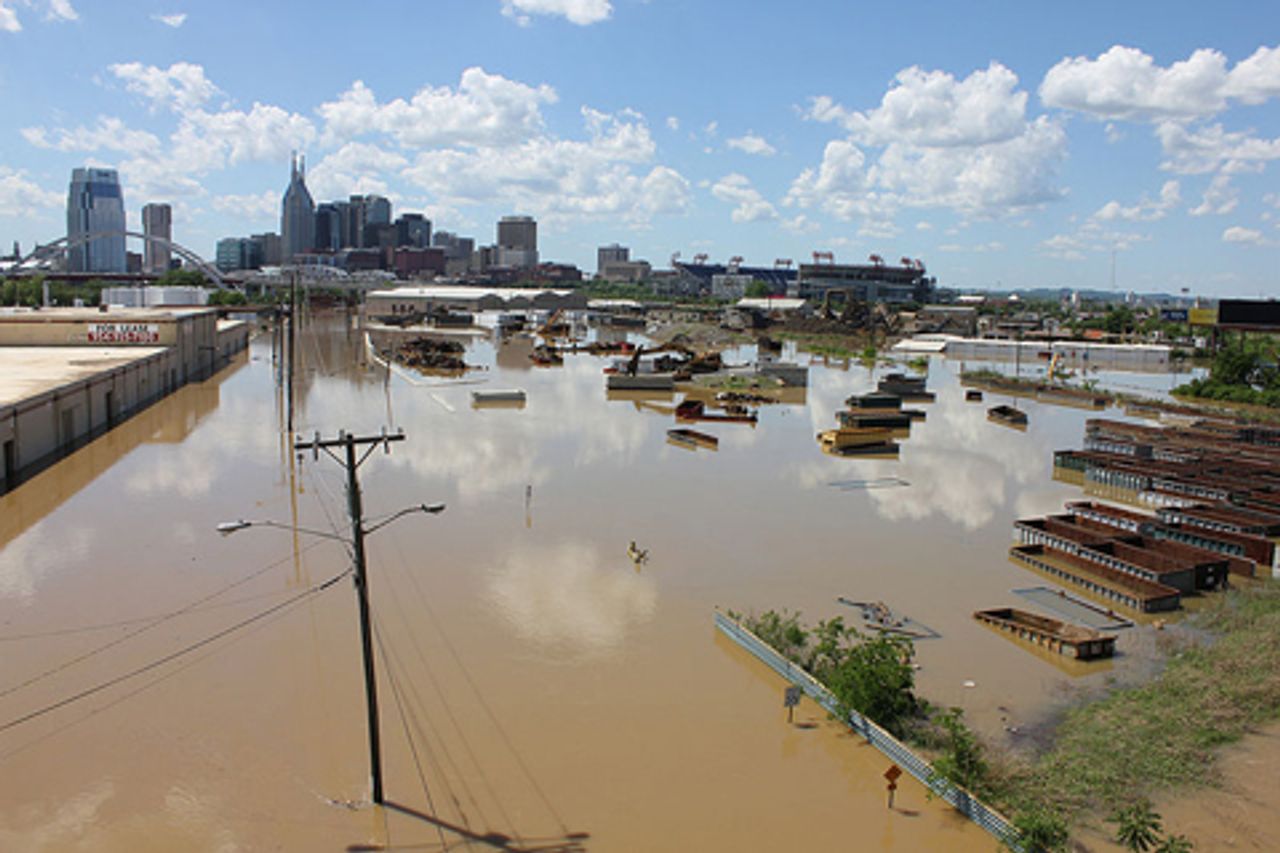Residents of storm ravaged Tennessee and Kentucky continue to assess the damage caused by the flooding that destroyed thousands of homes and businesses in the region. The death toll from the May 2 flood now stands at 33, and one Nashville man remains missing. Many parts of the two states have been declared disaster areas.
 Flooding in downtown Nashville, Tennessee in May 2010
Flooding in downtown Nashville, Tennessee in May 2010The city of Nashville was particularly hard hit by flooding after the Cumberland River rose to 52 feet on May 3, overwhelming the half-century old dam and levee system. As with so many recent natural disasters in the US, the damage caused by the elements has been magnified by the deteriorating and inadequate state of the national infrastructure.
Army Corps of Engineers officials in Nashville, concerned that the dam would wholly give way under the rising water, ordered the release of some 5.4 billion gallons into the Cumberland, which rapidly spilled over the banks into the city.
According to an Associated Press report, during normal operations, the Old Hickory Dam on the Cumberland releases water for hydroelectric power generation at about 24,000 cubic feet per second. On May 2, water was jetted out at over 212,260 cubic feet per second, with workers opening the gates “wider and wider as often as every 15 minutes,” the AP reported. “In a little over 24 hours, the dam went from releasing no water from its spillway gates to opening them up completely.”
At least 11 residents were killed. Initial private property damage in the city has been estimated at $1.5 billion. Many of those affected, particularly among the poor, had no flood insurance.
Flood victims said they had not been given adequate warning of rising water levels, or notice of the decision to release the huge additional amount of floodwater into the river. The Tennessean newspaper reported May 14 that residents of the Rivertrace Estates subdivision and other neighborhoods were taken by surprise by the disaster and were forced to rely on word of mouth information from neighbors.
In one case, “They took their cue to evacuate from a neighbor’s cousin working at Old Hickory Dam,” the president of a homeowners’ association told the paper. That night, residents joined a “mass fleeing” to escape with their lives.
In Cheatham County, downstream from Nashville, flooding was extensive. Local news channel 5 reported May 12 that more than 2,000 public school students will not return to classes this year because of the severe damage to schools and roads. Much of middle and western Tennessee has suffered similar damage, although few counties have released damage estimates and press reports are thin.
The financial aid required to rebuild far exceeds the amounts pledged from the Obama administration or state governments in Tennessee and Kentucky. The Federal Emergency Management Agency (FEMA) has pledged $87 million to the entire state of Tennessee. Not including damage to the public infrastructure, such as roads and schools, the damage in Nashville alone is over 17 times this amount. Initially, the Obama administration offered a mere $4.1 million in FEMA aid for the state.
Flood victims have relied largely upon the charity of their neighbors. Volunteers in Nashville have worked tens of thousands of unpaid hours manning distribution sites and going door to door with aid. As heroic as these efforts are, without a massive influx of financial relief and trained personnel, residents cannot meet the enormous challenges of repairing communities and infrastructure, and caring for the poor, disabled and elderly who are among those who lost the most. (See accompanying interviews: “Mid-South flood survivors speak to WSWS”)
The Tennessean carried a report May 13 on the gaps in emergency assistance. At the East Park Community Center, the paper stated, “One man who arrived at the city designated disaster information center needed to know how to report a gas leak, but no one from the gas company was there to answer questions. During the day, about a dozen people came for tetanus shots, but no one was there to administer them.”
A spokesman for the city’s health department told the paper that nurses were supplied with only 100 tetanus shots on May 11, but left the East Park center once they ran out, and didn’t return the following day because they didn’t receive anymore stock.
The Tennessean also noted, “There were booths set up for the Federal Emergency Management Agency, Red Cross and the Metro Health Department, but they were unmanned.” Volunteers at the center told the paper they had been empty that day and the day before.
The author also recommends:
Nashville, Tennessee struggles in flood’s aftermath
[12 May 2010]
Deadly storms, flooding hit US mid South
[4 May 2010]
